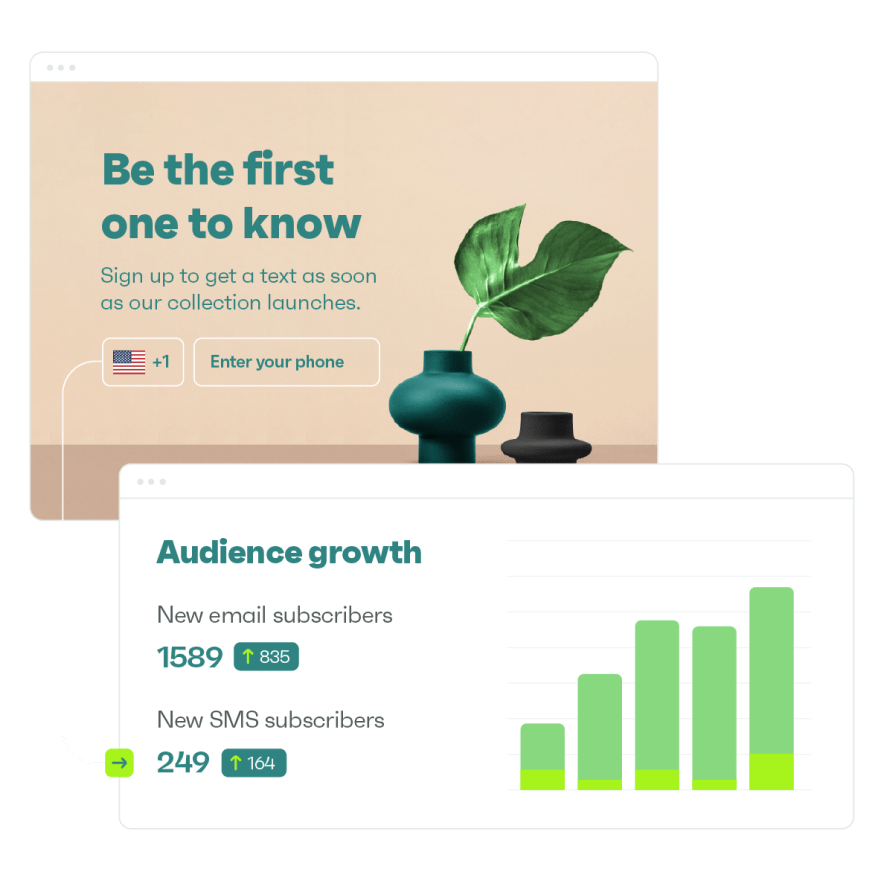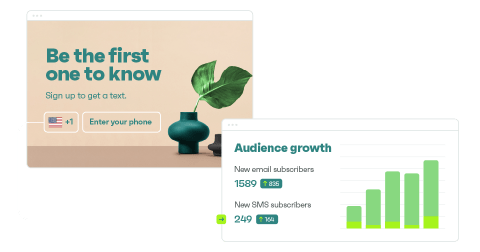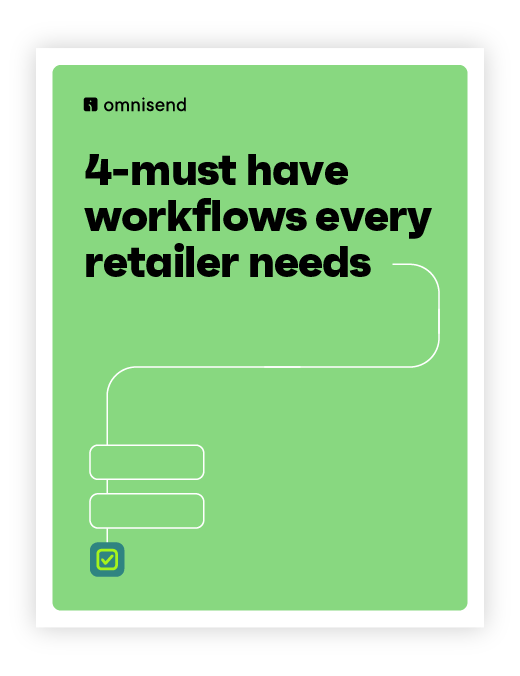Drive sales on autopilot with ecommerce-focused features
See FeaturesEmail marketing for ecommerce: 9 winning campaign types to drive sales
Despite the increasing number of channels available to ecommerce businesses to reach their customers, email continues to be the most promising. Statistics show that ecommerce email marketing continues to deliver an impressive $36 for every $1 spent — but only when used right.
With customer acquisition costs increasing by almost 60% it’s time for brands to rework how they use email — no, the standardized ecommerce email marketing automations are no longer enough!
If you want your email to stand out from the 347.3 billion sent and received every single day this year, this guide is for you.
We will cover the absolute basics of email marketing for ecommerce, and share email marketing ideas, must-have automations, templates, and examples. We’ll also recommend some of the best email marketing software for online businesses.
Feel free to use this table of contents to jump to the most relevant section:
- Why should you use ecommerce email marketing?
- What are the types of emails ecommerce businesses should send?
- What are the best practices for ecommerce email marketing?
- How to create an ecommerce email marketing strategy
- Which is the best email marketing tool for ecommerce
What is ecommerce email marketing?
Ecommerce email marketing refers to a marketing strategy where online businesses use emails to reach out to and engage their existing or potential customers. Ecommerce businesses use emails to promote new products, deals, and discounts, send out transactional information, order updates, abandoned cart reminders, or keep their subscribers up to date.
These emails can be sent as one-time campaigns or automations based on consumer data (behavior, interaction, previous purchases, etc.) to drive business objectives like awareness, cart recovery, engagement, and sales.
Why should you use email marketing for ecommerce?
Yes, there are several channels and platforms that you’re already focusing on to reach your target audience and keep customers engaged. But here’s why we recommend bringing back your focus to ecommerce email marketing:
1. It’s efficient, effective and direct
Emails are among the most used channels for personal and professional communication across all demographics. According to the McKinsey Global Institute, people check their email on average 11 times per hour, and 84% keep emails open in the background while working.
Simply put, ecommerce email marketing gives you a chance to reach customers via a channel they’re already active on!
2. It’s more targeted and personalized
From paid campaigns and newsletter popups, to order checkout and referrals, ecommerce businesses collect email addresses in many ways. The good thing is that you can keep the subscribed customers well-segmented based on various data points — where and when they subscribed, their intent and interest, and what type of messages they want to receive.
Compared to other channels like social media, this enables you to personalize your ecommerce email marketing campaigns better. When 73% of customers expect brands to understand their needs and personalize messages, this helps get your message noticed!
3. It’s the most flexible channel
With the increasing noise on other channels, businesses are forced to keep up with a higher frequency of sharing content. For instance, you can see online brands sending at least one message daily, publishing 2-3 social media posts every day, and so on to stay on top of the consumer’s mind.
But when it comes to email — it is a channel the consumer willingly opts in to be notified on. Apart from the regulations and compliances it comes with, it lets the business and their consumer decide how they want to use the channel — for one-off promotional campaigns, only transactional and order updates, or engagement campaigns.
It’s entirely in your control, and you can also give customers a choice to set the pace!
4. It’s more cost effective than other channels
Paid ad campaigns across social media channels and search are becoming costlier by the day. You’re not just competing with similar stores but ad campaigns from other industries as well. The average internet user is exposed to nearly 10,000 ad campaigns per day!
Emails, on the other hand, owing to their direct nature, don’t require continually increasing your bids. It is one of the most cost-effective channels to drive sales, delivering a higher conversion rate and ROI than others.
5. It’s effective at building brand recall
Emails can be branded right from the sender’s name, subject line, design, messages, and the way you sign off. This gives ecommerce businesses more control over how they present the brand, using consistency in their favor to build better brand recall.
In comparison, other channels have several restrictions like formats, dimensions, viewability, character limits, and more that restrict how a brand wants to be perceived. Brands need a lot more effort to create a consistent look and feel on those channels.
But to be able to tap into the opportunity that email marketing for ecommerce brings, you need to plan out campaigns at different stages of the consumer journey.
What are the types of emails ecommerce businesses should send?
While there is no one set way of using email marketing for ecommerce, we do recommend setting up the following email marketing ideas:
1. Welcome emails
A welcome email is the first interaction between your business and a new email subscriber. Once they are interested in your brand, 8 out of 10 customers expect to receive welcome emails.
These emails mark the beginning of a consumer’s journey with your brand. Their goal is to confirm a new registration, set expectations on what a consumer can expect in emails, share more details about your brand or seek more information about their interest in the brand — there is no direct selling here.
When strategized well, welcome emails have an average open rate of 30.69%, a 202% lift over usual email campaigns.
Here’s a welcome email example that shows how a consumer still controls the messages they receive, reinforces the benefits of staying subscribed, and offers a first-purchase discount to nudge the first action.

2. Promotional emails
Based on what a consumer has shown interest in, use ecommerce email marketing campaigns to run promotions. This could include highlighting new products or collections, a best-seller, an ongoing discount or deal, or creating hype around an upcoming event!
Promotional emails are also great for running flash sales. Since the discounts are more time-sensitive, these emails get your message noticed almost instantly and help drive traffic to your online store in no time.

3. Browse or cart abandonment emails
Due to the increasing competition for consumer attention, ecommerce stores see an average cart abandonment rate of 69.99%. Some industries also experience a cart abandonment rate of almost 80%!
Browse abandonment emails get triggered when a store visitor browses through your website. They explore collections and products and add items to their wishlist — but do not move to checkout. These emails help attract online shoppers by reminding them of the items they liked, recommending similar products, or highlighting a deal that would boost their purchase intent.

Similarly, cart abandonment emails are messages to bring back shoppers who added products to the cart but did not complete the purchase. These emails remind them of the product they left behind, give them reasons to buy it (social proof, popularity), and send a little purchase motivation through a special discount.

4. Transactional emails
As we mentioned before, transactional emails are informative messages to a customer. These typically include sending them confirmation on an order they have placed — order confirmation, payment receipts, expected delivery date, order delays, shipping notifications, or even refund/ return/ exchange/ cancellation notifications.
A study by HBR showed that more than 50% of customers experience post-purchase anxiety. Transactional emails are the perfect way to address it proactively!
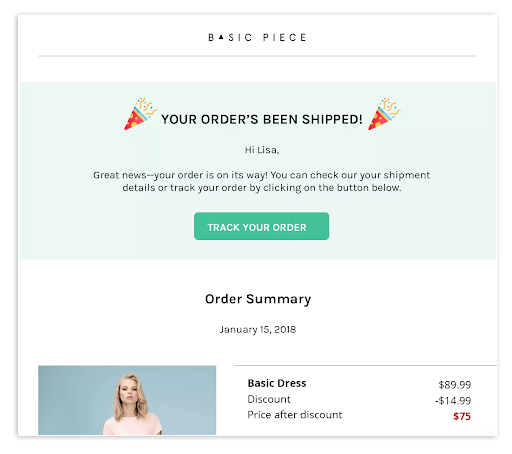
5. Birthday emails
Your ecommerce email marketing strategy shouldn’t just be about asking a subscriber to make a purchase. Use these emails as an opportunity to make your customers feel special too!
A birthday email is one such email that definitely helps with customer engagement and shows that you care. Use the email to congratulate your customer on a day that matters to them, along with a special discount as a gift from your side.
You can automate these emails to be triggered a few days before the customer’s birthday to give them time to shop.
6. Holiday emails
Another way to keep your subscribers and customers engaged is to join in on key celebrations.
These include popular holidays like Valentine’s, Easter, Christmas, New Year, and other occasions. You can even segment your email list based on location demographics to make your holiday emails more contextual to them.
Holiday emails also give you more opportunities to connect with your customers without sounding too pushy!

7. Upsell and cross-sell emails
Ecommerce email marketing yields results when personalized to match a consumer’s intent, interest, and purchase preferences. Brands often have access to this data from customer account pages, wish lists, previous purchases, support requests, and similar activity that they can use for post-purchase engagement on email.
Upsell emails focus on introducing customers to an upgraded version of what they have bought before. The idea is to use their previous purchase to indicate what they need now for an enhanced experience. While this may include introducing them to a product of higher value, it also shows them its benefits.

On the other hand, cross-sell emails are meant to introduce the customer to products that are similar to or complement the purchase they have made. The idea is to help them correlate different products, get them to explore more items in your store, and address their related needs to increase customer loyalty.

8. Back in stock or restock emails
While going out of stock is a sign of success, it also is the start of losing potential sales when you don’t meet an interested consumer’s needs.
Instead of pushing them away to a competitor to make the purchase, let them subscribe to restock notifications instead. And the day you replenish, remember to immediately reach out to these interested customers with a restock email!

9. Review request and customer feedback emails
As an ecommerce business, you need to adapt to consumer needs continually. But to be able to do market research is not enough — use ecommerce email marketing campaigns to get insights from your customers.
Product review request emails are a great way to gauge how customers feel about a purchase. These emails are typically sent a few days after the order is delivered, giving customers enough time to use or experience them. They are focused on getting inputs on product-specific aspects from the customer — like material quality, sizing, fit, etc.
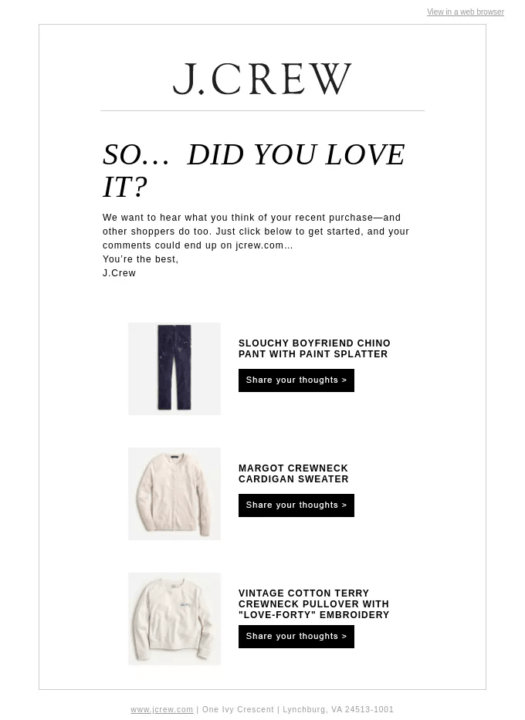
On the other hand, customer feedback emails are more generic in nature. They focus on understanding how customers feel about shopping from your website or brand. This can include their general sentiment over how easy it is to shop from you, how they feel about the products in your store, and what more they’d like to see in the future.

What are the best practices for ecommerce email marketing?
Simply setting up different types of emails for your ecommerce site is not enough. Since the number of brands using email has increased, ensuring your messages don’t add to the noise has become essential.
Here are some ecommerce email marketing best practices we recommend following:
1. Build (don’t buy) your email list
Building an audience is as challenging as driving the right customers to your online store. It can take time to build an email list, but we strictly discourage buying one.
It’s important to note that when customers willingly subscribe to your email list, they are more likely to engage with your campaigns. This helps drive higher engagement, conversions, and ROI from the marketing channel.
A few promising ways to build an email list include:
- Set up popups on your website — Use exit-intent popups to encourage store visitors to subscribe, and you can use a special discount to incentivize them.
- Create signup forms for easy contact — customers want to interact with brands before buying from them. Set up contact forms to make it simpler for them to reach you.
- Implement newsletter signup — If you’re using content marketing or social media to reach your target audience, set up an easy newsletter signup form for them.
- Use strategic gamification — Make subscribing to your email list fun by using gamification, such as the spinning Wheel of Fortune.
- Create custom landing pages — If you’re promoting a specific product or a deal, you can also set up a separate landing page that customers can use to get updates.
2. Use double opt-in for subscribers
Due to the increasing number of compliances that businesses need to follow, you must be absolutely sure a consumer wants to hear from you. We recommend setting up a double opt-in as you implement multiple strategies to build your email list.
A double opt-in occurs when a consumer signs up to an email list, and then an email is sent to confirm the same. The ecommerce business can only reach out to this consumer if they confirm their subscription.


The best way to ensure that customers don’t drop out is to ensure you reinforce the value you will offer in emails. It’s also a good idea to provide easy opting out or choosing preferences.
3. Actively segment your email list
Everyone’s sending emails.
If you want yours to be engaging, we recommend making them contextual to a buyer’s journey and interest.
As you build an email list, ensure you have proper segmentation in place.
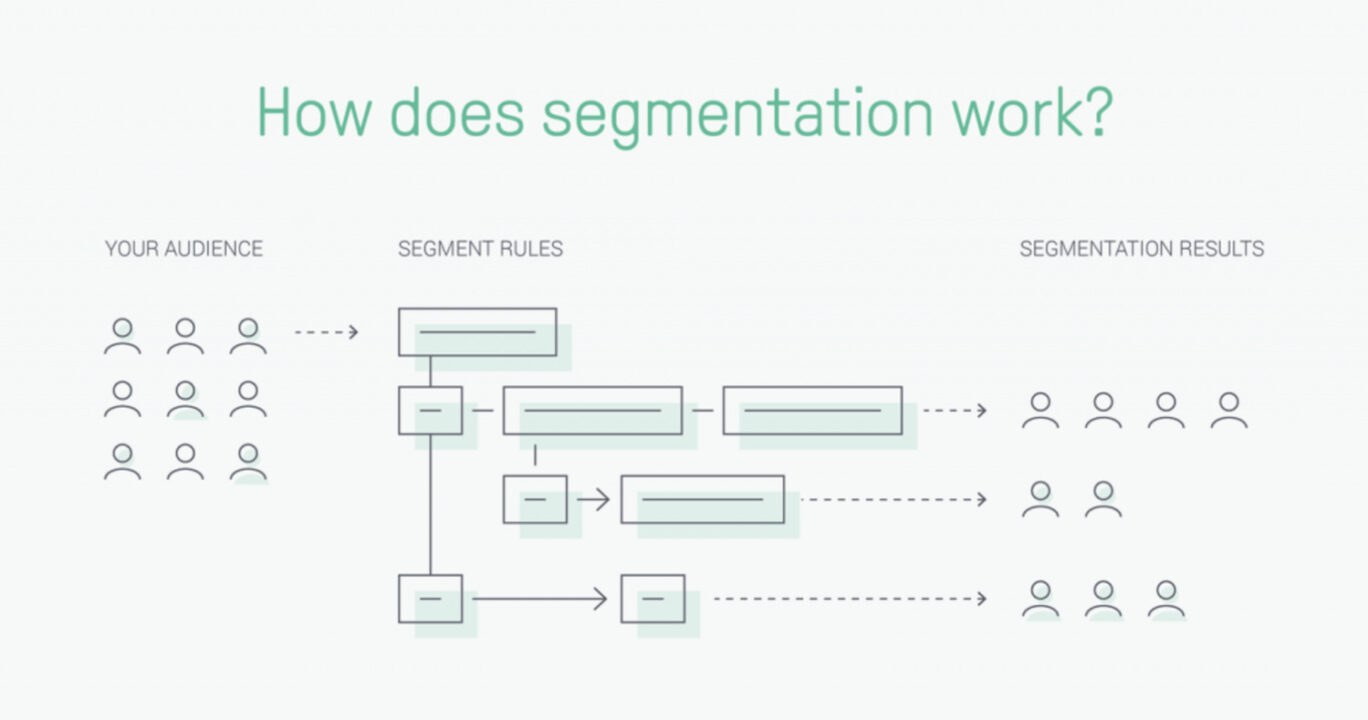
This should not just be based on where and when a consumer subscribed to your list. Here are two other key segmentation parameters to use:
- Behavioral segmentation — This refers to grouping customers together based on their behavioral patterns. These patterns include previous purchases, campaigns they have engaged with, how frequently they do so, how long they spend on the website, and similar actions across the customer lifecycle.
- Demographic segmentation — This refers to grouping your subscribers based on demographic data like location, age, gender, income, and more. These data points help identify common needs and interests.
- Advanced segmentation — This refers to segmenting customers based on their personal data or individual interactions. These data points include aspects like the type of discounts they availed, frequency of purchases, etc.
4. Keep your list clean and healthy
Since growing an email list is challenging, ecommerce businesses often skip cleaning it.
Email list cleaning is updating your email list by running a hygiene check. This includes removing fake, duplicate, invalid, and inactive email subscribers. It also includes frequently reaching out to your email list to honor unsubscribe requests.
Making list cleaning a part of your ecommerce email marketing strategy will ensure that you are reaching the right customers at the right time, with the right message, and at optimized costs.
- Improve customer segmentation
- Improve email deliverability
- Boost email engagement rate
- Increase email conversion rate
- Increase email marketing ROI
5. Use a responsive email design
Over 61.9% of emails are opened on mobile devices.
But some customers choose to check emails only on desktops.
Either way, the experience of reading and interacting with your emails should be seamless. This begins by choosing a responsive email design that adapts your content, visuals, and overall layout based on the customer’s screen size.
In addition to choosing a responsive design, we recommend doing a quick manual check on the length of emails for smaller screen sizes. Imagine browsing for 30 seconds to find a call to action button!
6. Give your email copy more love
Don’t treat emails like just another channel to run promotions.
Pay more attention to your email copy to create something engaging yet contextual for your subscribers.
- Use catchy email subject lines
- Format your email body for readability
- Use short sentences and paragraphs
- Write a clear call to action
- Use headings, bold, italics, and strikethrough smartly
- Make use of emojis
- Infuse your personality in your tone of voice
7. Use consistent branding
With inboxes becoming crowded, the sender name is no longer good enough to brand your emails.
Remember to keep a few things visually consistent for your subscribers.
These include the header and footer of your emails, the general email design layout, the tone of voice, the theme of visuals you use (presets), the logo, and the contact information you provide.
8. Include high-quality visuals
No one likes reading a block of text, but no one likes broken or low-quality visuals either!
Whether you include product images or videos in the email, ensure the quality is fully retained — regardless of which device a recipient opens the email on.
It’s also important to keep in mind the weight of these visuals so that they don’t break when viewed on a low-quality network.
9. Leverage dynamic content
Personalizing emails is of utmost importance to drive higher conversions.
No matter how many segments you create, personalizing on individual levels is impossible.
This is where using dynamic content can come in handy.
An example of dynamic content is using personalized recommendations as an additional block in your segmented emails.
So while one part of your email remains standardized, the recommendations displayed in the block remain personal to each subscriber.
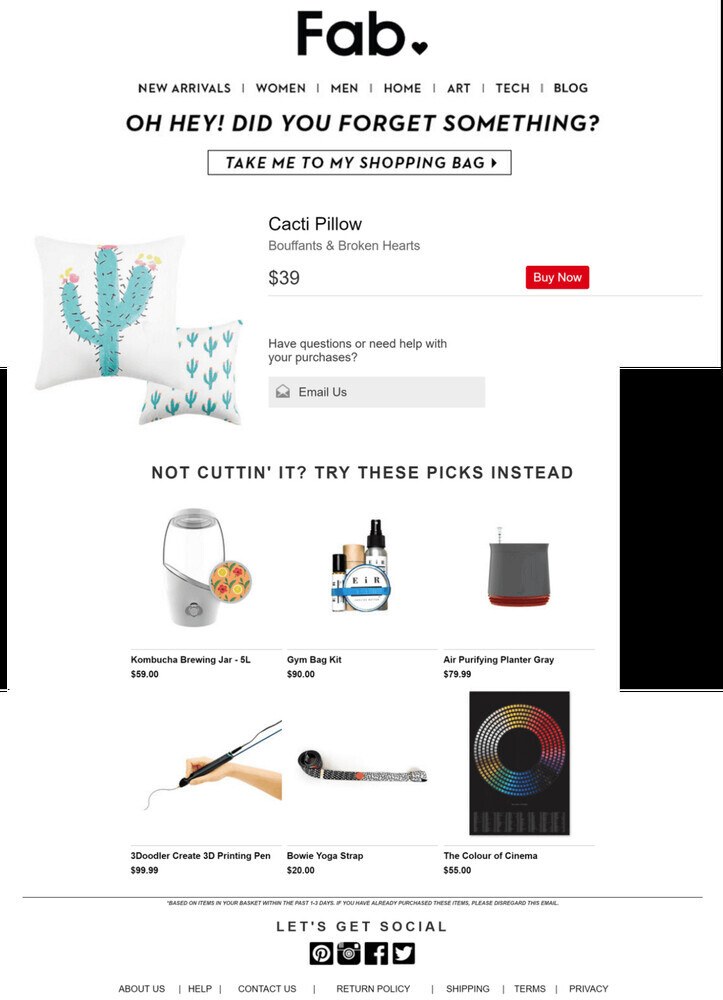
10. Run frequent A/B tests
Creating email marketing campaigns that resonate with the new-age consumer is easier said than done.
It takes more than just using their [first name] or including an enticing discount, and you never know what resonates with whom.
This is why A/B testing should be a part of your ecommerce email marketing strategy. Some things you can experiment with easily include:
- Welcome email messages
- Delays in abandoned cart recovery messages
- Email content
- Subject line format
- Font, font color, size
- Call to action color, copy, and placement
- Incentives (discounts, offers, benefits)
Setting up A/B tests helps you experiment and iterate faster, using emails as an effective sales channel for your ecommerce business.

11. Monitor, analyze and optimize campaigns
Don’t treat any of your email automations as a one-time setup.
Consumer needs and preferences change with time.
The emails they engage with now may not interest them in the future.
The only way to promptly catch up with these changes is to keep track and optimize of ecommerce email marketing metrics.
Some of the key ecommerce email marketing metrics we recommend measuring include the following:
- Conversion rate
- Open rate
- Email ROI
- Click-through rate
- Bounce rate
- Spam rate
- Unsubscribe rate
How to create an ecommerce email marketing strategy
Emails have been around for a while, and marketers have become passive about how they plan communication on this channel. Whether you’re getting started with ecommerce email marketing or are revamping your strategy, here are some of the steps we recommend following:
#1 step: Identify your key consumer touchpoints
The first thing you need to consider is how you will get customers to opt in to your email list. Identify all the critical consumer touchpoints you can leverage to invite potential and existing customers to join you willingly.
This includes your ecommerce store, sale landing page, blog with newsletter signup forms, contact page, social media accounts, paid ad campaigns, and other communication channels you may be using.
#2 step: Set a clear goal and objective
The next step is to clarify what you want to achieve from ecommerce email marketing. This will help you plan out the campaigns in a more streamlined and focused manner.
The following questions can help you at this point:
- What do you want to use emails for at your company?
- What is the overall goal of the campaign (boost awareness, engagement, retention, or drive more traffic/ sales, etc.)?
- What metrics are you trying to improve (subscriber list, website traffic, engagement rate, sales, repeat sales, etc.)?
- When do you need to achieve this goal?
- Who are your email subscribers?
- Which segments of your subscriber list will you target?
- Where are your subscribers reading your emails (desktop, mobile)?
#3 step: Understand the different types of emails
Once you have the answers to the above, it’s essential to understand the different types of emails ecommerce businesses should be sending. This should include an understanding of the different campaigns that fall under each and what purpose they solve.
While we will cover the types of emails your ecommerce business should send in the section below, here are the three broad categories they fall under:
- Transactional emails: These are emails sent to customers when a purchase action occurs. Transactional emails include critical information like order confirmation, purchase receipts, and shipping and delivery notifications. They are personalized and highly relevant to individual customers.
- Promotional emails: These emails are designed to help businesses boost awareness about a product, discount, deal, or sale they’re running. For example, a new collection launch or the announcement of the BFCM sale.
- Lifecycle emails: These emails are also referred to as ‘triggered’ emails as they are dependent on consumer actions. For example, a welcome email when a new visitor subscribes, or a cart recovery email when someone abandons a product they added to their cart.
#4 step: Create a customer journey map
It’s important to understand that emails are still a channel away from your online store. This means your emails are intended to drive an action that brings the recipient to your website in one way or another — be it to browse through a new collection or discounts, create a wishlist, or complete a purchase.
This is why creating a customer journey map for each type of email campaign you intend to send is important. The map should include the key steps a consumer will need to take to complete a desired action and the follow-ups required if they drop off beforehand.
As a general practice, it’s vital to keep the steps in your map as optimized as possible!
#5 step: Equip yourself with the right email marketing tool
The next thing you should get out of the way is how you will send the emails.
It is important to note that taking a manual approach is not the best as you grow. You may miss out on crucial moments in a buyer’s journey, leading to drop-offs or losing potential sales.
Find an ecommerce email marketing software with everything you need to set up different campaigns. This should typically include pre-built and customizable ecommerce email marketing automation workflows across the customer lifecycle, easy integration with your store, email design templates, analytics to track performance, and support to optimize the channel for more sales.
We’ve also shared the best ecommerce email marketing tools in a section below to help you shortlist and find the right solution with ease.
Want to deep-dive into creating an ecommerce email marketing strategy? Read this article first.
Now that we have an ecommerce email marketing strategy in place, let’s move to understand the types of emails your customers expect to be sent.
Which is the best email marketing tool for ecommerce?
There are several ecommerce email marketing software out there.
While each offers a similar feature set, there are distinct functionalities and focus that may make or break the success of your ecommerce email marketing strategy.
That’s why we have shortlisted some of the best email marketing software for ecommerce:
#1 Omnisend
Features
- Email templates for ecommerce — Wide selection of conversion-focused email templates that can be customized for your branding.
- Pre-built automation workflows — Set up automated campaigns such as welcome emails, abandoned cart emails, and re-engagement campaigns in minutes.
- Customize email marketing automations — Easy-to-use email builder to further tailor workflows to personalize shopping journeys for customers.
- Personalization — Easy personalization options such as subject lines, images, and content using customer data.
- Segmentation — Allows businesses to segment their email lists based on various criteria, such as behavior, location, and purchase history.
- Advanced A/B testing — Easily test different subject lines, images, call to actions, or even workflows for different subscriber segments.
- Analytics and reporting — In-depth analytics to measure open, click-through and conversion rates on campaigns, along with sales reports.
- Omnichannel set up — Ability to send email automation flows together with SMS and push notifications.
- Set up lookalikes or re-engagement — Ability to set up Google Ads and Facebook retargeting by syncing with your email campaigns.
- Easy setup — Full integration with all popular ecommerce platforms.
Pricing:
- Free plan (up to 500 emails and push notifications/month)
- Paid plans start from $16/month (for up to 500 subscribers — emails, SMS and push notifications)
#2 Mailchimp
Features
- Campaign creation — Create and send email campaigns including ecommerce and automated messages.
- Email designer — Drag-and-drop email designer to create branded emails with minimal design skills.
- List management — Easily add, remove, update and segment your email subscribers based on activity.
- Behavioral automation — Use subscriber behavior as email campaign triggers, including cart abandonment, welcome emails and win-back campaigns.
- Reporting and analytics — Track the performance of your email campaigns with a detailed analytics dashboard.
- Personalization — Use merge tags to personalize your emails with consumer information, such as name or purchase history.
- A/B testing — Test different elements of your email campaigns, such as subject lines, content, and send time.
Pricing
- Free plan for up to 2,500 emails
- Paid plans start from $13/month (for up to 5,000 subscribers)
#3 Klaviyo
Features
- Email builder — Drag and drop email editor with custom fields to design emails easily.
- Pre-built automations — Comes with pre-built ecommerce email marketing automation workflows that can be customized further to meet business objectives.
- A/B testing — Easily A/B test subject lines, content and send time for up to 25 versions.
- Other marketing channels — Manage popups, SMS and social media campaigns in sync with your email marketing strategy.
- Analytics dashboard — Track and visualize customer data and marketing campaign performance along with user flow reports.
- Smart segmentation — Group subscribers on the basis of information, activity and demographics.
- Integrations — Easily integrates with popular ecommerce platforms and marketplaces.
Pricing
- Free plan for up to 500 emails
- Paid plans start from $20/month (for up to 500 subscribers)
Ready to get started with ecommerce email marketing?
No matter which marketing channels you’re currently active on, emails will still hold a lot of value in staying in touch with your customers.
To start with, it’s the only channel where you own your audience and control how they perceive your brand.
But like every other marketing tactic, ecommerce marketing needs to evolve and adapt to consumer needs.
This is where having the right ecommerce email marketing software can come in handy.
Not sure where to begin?
Get started with ecommerce email marketing with Omnisend to access expert support and assistance.
quick links
related features
No fluff, no spam, no corporate filler. Just a friendly letter, twice a month.
